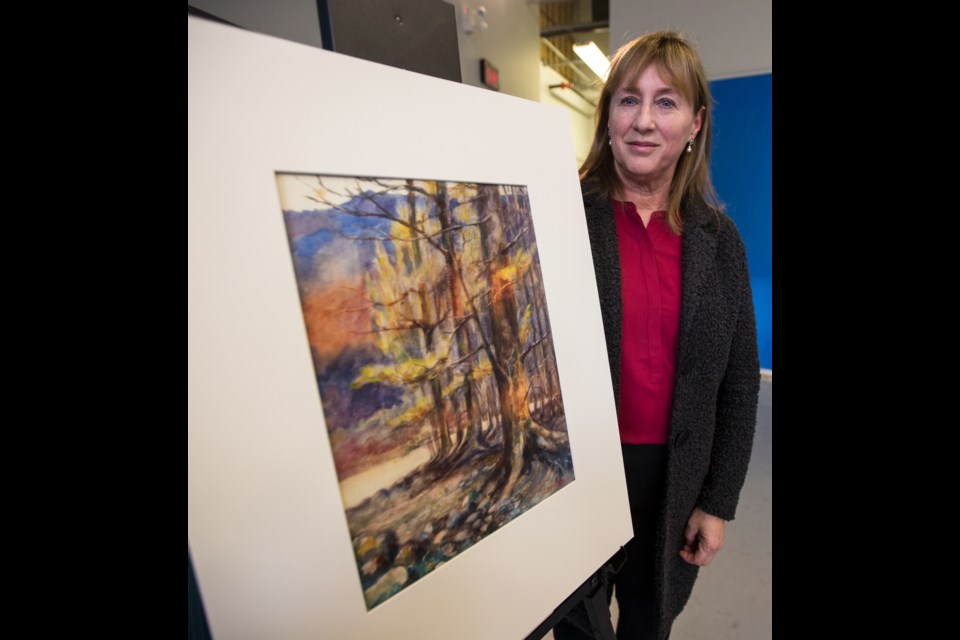Two Emily Carr creations acquired from a Zimbabwe-based descendent of a friend of the artist — a watercolour painting and a seven-page “funny book” — were unveiled Wednesday at the Royal B.C. Museum.
“These works are a glimpse into Emily Carr’s early life as an artist, and a glimpse into her loyalty and affection for her lifelong friend,” said Angela Williams, the museum’s deputy chief executive and vice-president of collections, research and international programs. “It also shows the distance that her art travelled.”
The book and undated watercolour, thought to depict a B.C. forest, were purchased for $40,000 in late November, with funds coming from the Royal B.C. Museum Foundation.
“Funny book” is what Carr called works that combined cartoonish ink sketches and verse, which in this case tell the story of Carr and close friend Hannah Kendall braving the crowds to try to get a look at Queen Victoria’s funeral procession in 1901 London.
The book had been disassembled and the pages separately framed by the time it came into the museum’s possession.
Carr referred to her verse as “doggerel,” said Don Bourdon, the museum’s curator of images and paintings. He said such books by Carr were something of a prototype for comics.
“She had no pretensions about being a poet,” he said. “This was all for fun.”
The acquisitions are now part of the museum’s Emily Carr collection of more than 1,100 pieces, the largest and most complete Carr collection in the world, she said. “Where other art galleries and institutions generally only hold her paintings, the Royal B.C. Museum and Archives is able to showcase aspects of Emily Carr’s entire life through her own art, writings, photographs and other [material].”
Kathryn Bridge, a curator emeritus at the museum and a Carr authority, said the tale of how the painting and book came to be acquired started with a random email from Zimbabwe about seven years ago. “I opened it and started reading it, and if someone had been in my office, they would have seen my jaw drop.”
It was from Kendall’s great-niece, who wanted to find out more about the Carr items that were handed down to her. The items ended up being sent to the museum on loan in 2011, and were subsequently used in an exhibit and a publication before the eventual purchase.
Bridge said she was surprised that the items from Zimbabwe fared so well over the years in a place where there was no “firm understanding” of who Carr was.
The museum was contacted about the items because of its reputation, Bridge said.
“The reason we got the email in the first place is because we are really Emily Carr central,” she said. “We don’t have the big, flashy paintings that cost millions of dollars, but what we have is a very strong and unique archival collection, a collection that documents Emily Carr in ways that researchers can use to write books, to do exhibits.”
Bridge said that a Carr gallery is part of the museum’s master plan.
Wednesday’s introduction of the Carr items came in a section of the museum that is being turned into a state-of-the art learning centre, Williams said.
“It will transform the museum and archives, creating a rich multi-dimensional experience for visitors no matter where they’re located — here in Victoria, across British Columbia or around the world,” she said.
A sample of Carr’s verse (note that Carr uses the spelling Kendal rather than Kendall and doesn’t always use apostrophes):
At six o’clock from sleep I wake
By Kendal who my pillows shake,
Will you get up you lazy Carr?
The sun o’er chimney-pots afar
Is rising and tis deep transgression
To sleep and miss todays procession
Oh, slowly out of bed we rise
With woeful, weary, sleepy eyes,
Tis half-way dark and chilly too
And Kendals nose is red and blue



